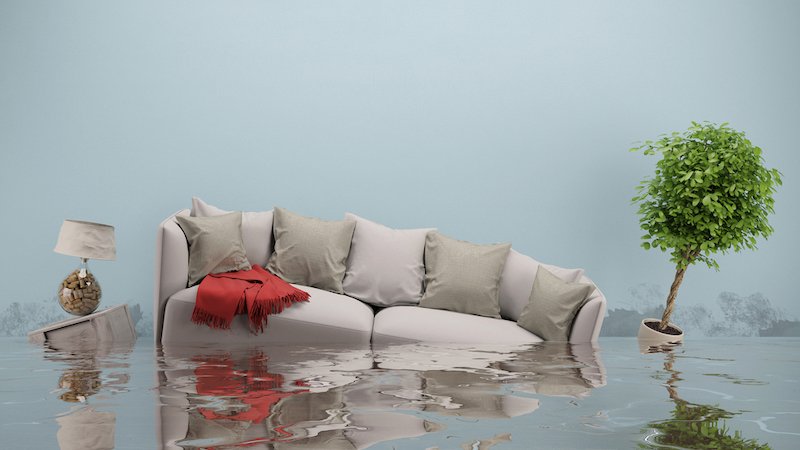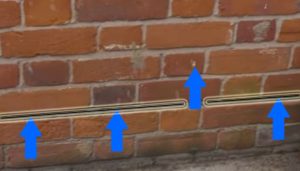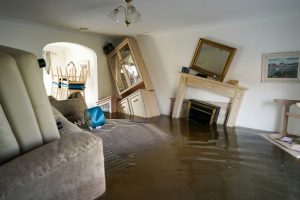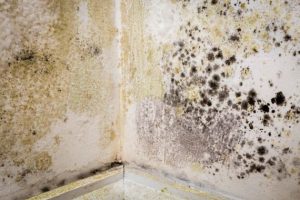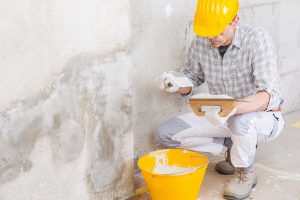The water table is the level at which the ground beneath the earth’s surface is saturated with water. It’s relevant when diagnosing damp, because permeation of water through various substratum could potentially include the footings or basement of your property.
If the water table is high, the soil around the property can become saturated with water, leading to water seepage into the foundations and walls. This can cause rising damp, which occurs when water from the ground is drawn up into the walls by capillary action. As the water evaporates from the surface of the walls, it leaves behind salts that can cause damage to the plaster and paintwork.
On the other hand, if the water table is low, the soil around the property may become too dry, causing the soil to shrink and pull away from the foundations of the property. This can create gaps and cracks in the walls, which can allow moisture to enter the property, leading to problems such as penetrating damp.
What Exactly is the Water Table ?
The water table is the level below the ground surface where the soil, clay and chalk are saturated with water. It can vary depending on factors such as rainfall, soil type, and topography. Here are some examples of the water table:
-
High water table: In areas with high precipitation or low permeability soils, the water table can be close to the surface. This can cause issues with building foundations, especially in low-lying areas or near bodies of water.
-
Low water table: In areas with low precipitation or permeable soils, the water table can be several meters below the ground surface. This can lead to issues with access to water for agriculture or drinking.
-
Seasonal water table: In areas with seasonal precipitation, the water table can fluctuate throughout the year. During the wet season, the water table can rise, causing flooding, while in the dry season, it can drop, causing issues with water scarcity.
-
Confined water table: In areas with impermeable rock layers, the water table can be confined to a particular layer, forming an aquifer. This can be a vital source of water for agriculture or drinking.
Understanding the water table in a particular location is crucial for managing water resources, building foundations, and preventing issues with dampness in properties.
Controlling the Effects of the Water Table to Protect Your Property
Controlling the effects of the water table and preventing damp in your property can be a challenging task. However, here are some steps you can take to reduce the risk of dampness caused by the water table:
-
Check the water table level: The first step to preventing damp is to determine the level of the water table in your area. This information can be obtained from local authorities or an independant groundwater specialist. This will help you to determine the potential risk of groundwater affecting your property.
-
Proper Drainage: Ensure that your property has proper drainage and that water is not accumulating in or around the property. Install proper drainage systems around your property to prevent the accumulation of water. Sufficient sized gullies with unobstructed underground pipe should preferably be connected to mains drainage. Where mains drainage is not available, a correctly sized soakaway should be installed a minimum of 3m beyond the property. French drains, channel drainage and the installation of underground drainage duct to protect the foundations should also be considered.
-
Install a Damp Proof Course (DPC): DPC is a layer of material inserted into a wall to prevent moisture from rising. If you suspect that the water table may be high, consider installing either a physical or chemical DPC to prevent dampness.
-
Waterproofing: You can also waterproof your walls and floors to prevent water penetration. Waterproof coatings or membranes can be applied to the exterior of your property’s foundation walls or concrete slabs.
-
Ventilation: Where moisture from below ground level has already pervaded the property, good ventilation can help to reduce the build-up of condensation and resultant mould and mildew. Passive ventilation will allow air to circulate and thus reduce atmospheric moisture content. However, when it’s apparent that dampness has already progressed to this stage, there should be an immediate effort to undertake effective damp proofing measures.
-
Regular Maintenance: Regularly inspect and maintain your property to ensure that there are no leaks or cracks that could allow water to seep in. Address any issues promptly to prevent further damage.
It is essential to remember that controlling the effects of the water table and preventing damp in your property requires a proactive approach. Regular maintenance, proper drainage, and waterproofing measures can help to reduce the risk of dampness caused by subterranean water.
In summary, the water table can have a significant impact on dampness in your property. It’s essential to take into account when considering a new home for your family, purchasing a buy-to-let property, or investing in premises for your business.
At Rochester Building and Damp, we can advise on measures to prevent or mitigate the effects of damp caused by the water table.
Contact Us today and we will be only to happy to provide FREE, No Obligation advice on this or any other damp related concerns.
I look forward to hearing from you,

